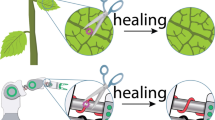Abstract
One unique property of a machine-augmented composite (MAC) is its ability to convert a compressive force into a shear force, and vice versa, simply by the geometry of its angled sidewalls. The authors have discovered that a non-spinning ball dropped at a normal angle onto the MAC’s surface rebounds from that surface at an oblique angle and develops a significant rotational velocity. Through finite-element analyses, analytical study, and experiments, the magnitude and direction of the spin can be precisely controlled by tailoring the stiffness of the MAC through the properties and dimensions of its constituent materials.
Similar content being viewed by others
References
G.F. Hawkins, “Augmenting Mechanical Properties of Materials by Embedding Simple Machines: A New Class of Composite Materials,” Journal of Advanced Materials, 34 (3) (2002), pp. 16–20.
G.F. Hawkins et al., “Machine Augmented Composites,” 9th International Symposium on Smart Structures and Materials (San Diego, CA: SPIE, 2002).
G.F. Hawkins et al., “Embedding Micromachines in Materials,” Proc. ICCM-14, (Dearborn, Michigan: SME, 2003).
Webster’s Seventh New Collegiate Dictionary (Springfield, MA: G. & C. Merriam Company, 1965), p. 506.
L.I. Howell, Compliant Mechanisms (New York: John Wiley & Sons, Inc., 2001).
R.J. Zaldivar et al., “The Fabrication and Mechanical Behavior of Z-shaped Machine-Augmented Composites,” Aerospace Technical Report, ATR-2002(8810)-1 (Los Angeles, CA: The Aerospace Corporation, 2002).
P.A. Maurone and F.J. Wunderlich, “Bouncing Ball Experiment,” Am. J. Phys. 46 (4) (1978), pp. 413–415.
N. Maw, J.R. Barber, and J.N. Fawcett, “The Role of Elastic Tangential Compliance in Oblique Impact,” Journal of Lubrication Technology, 103 (1) (1981), pp. 74–80.
R.G. Watts and S. Baroni, “Baseball-Bat Collisions and the Resulting Trajectories of Spinning Balls,” Am. J. Phys., 57 (1) (1989), pp. 40–45.
R. Cross, “The Bounce of a Ball,” Am. J. Phys., 67 (3) (1999), pp. 222–227.
R. Cross, “Measurements of the Horizontal Coefficient of Restitution for a Superball and a Tennis Ball,” Am. J. Phys., 70 (5) (2002), pp. 482–489.
R. Cross, “Grip-Slip Behavior of a Bouncing Ball,” Am J. Phys., 70 (11) (2002), pp. 1093–1102.
S.R. Goodwill and S.J. Haake, “Ball Spin Generation for Oblique Impacts with a Tennis Racket,” Experimental Mechanics, 44 (2) (2004), pp. 195–206.
Author information
Authors and Affiliations
Additional information
For more information, contact Gary F. Hawkins, The Aerospace Corporation, P.O. Box 92957 — M2/242, Los Angeles, CA 90009-2957; (310) 336-7379; fax (310) 336-5846; e-mail gary.f.hawkins@aero.org.
Rights and permissions
About this article
Cite this article
Tang, C.Y., O’Brien, M.J. & Hawkins, G.F. Embedding simple machines to add novel dynamic functions to composites. JOM 57, 32–35 (2005). https://doi.org/10.1007/s11837-005-0230-y
Issue Date:
DOI: https://doi.org/10.1007/s11837-005-0230-y




